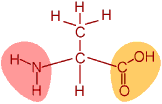|


Cook
amino acids and sugar and discover the range of aromas released!
|
 CAUTION
CAUTION
Kids, please don't try this at home without the help of
an adult. The corn syrup can get
very
hot, very quickly.
|
|
|
|
|
What
Do I Need?
|
.
|
|
•
pure corn syrup
|
 Did
You Know?
Did
You Know?
The
Maillard reaction
,
also known as the browning reaction, is what makes self-tanning
products work.
|
|
•
amino acid caplets (available at health-food stores)
|
|
•
a nonstick skillet
|
|
•
a
teaspoon
|
|
•
oven
mitts or hot pads
|
|
|
|
|
What
Do I Do?
|
|
|
1.
Put
about a teaspoon of corn syrup in the nonstick skillet.
|
|
|
|
|
2.
Open
one of the amino acid caplets and smell the powder inside. Does
it have a distinctive odor?
|
|
|
|
3.
Pour
the amino acid powder into the corn syrup in the skillet.
|
|
|
|
4.
Turn
the heat to high.
|
|
|
|
5.
Move
the skillet back and forth to better disperse the powder as
the corn syrup/amino acid mixture heats up and liquefies.
Do you smell a distinctive odor as the mixture heats up? Do
you notice more than one odor as the mixture continues heating?
What color is the heated mixture?
|
|
|
|
|
What's
Going On?
|
.
|
|
When
the amino acids and sugars are heated, they interact with each
other in a phenomenon known as the
Maillard
reaction
. The molecules of the amino acids and sugars combine
to form new aromas and flavors. The Maillard reaction is also
responsible for the brown color of cooked foods. It normally
occurs at very high temperatures, but if there is a high concentration
of sugars and amino acids, then it will occur at lower temperatures.
The Maillard reaction gives toast its distinctive flavor, beer
its distinctive color, and self-tanning products the power to
turn skin brown. It is responsible for literally hundreds of
flavor compounds, and is used to make artificial maple syrup.
|
 Share
& Discuss
Share
& Discuss
What did you smell when you cooked the amino acid caplets?
Take notes during the activity and
tell us
your results
!
|
|
|
|
|
What
Else Can I Try?
|
.
|
-
Try
mixing different amino acids together and see what aromas
occur.
-
Try
tasting the Maillard concoctions. Do this with friends and
see what different odors each friend smells. Have each friend
write down what they smell and do a poll at the end.
 Share
your results!
Share
your results!
|
|
*This experiment was suggested by Harold McGee in his book
The Curious Cook
(San Francisco: North Point Press,
1990).
|
|


